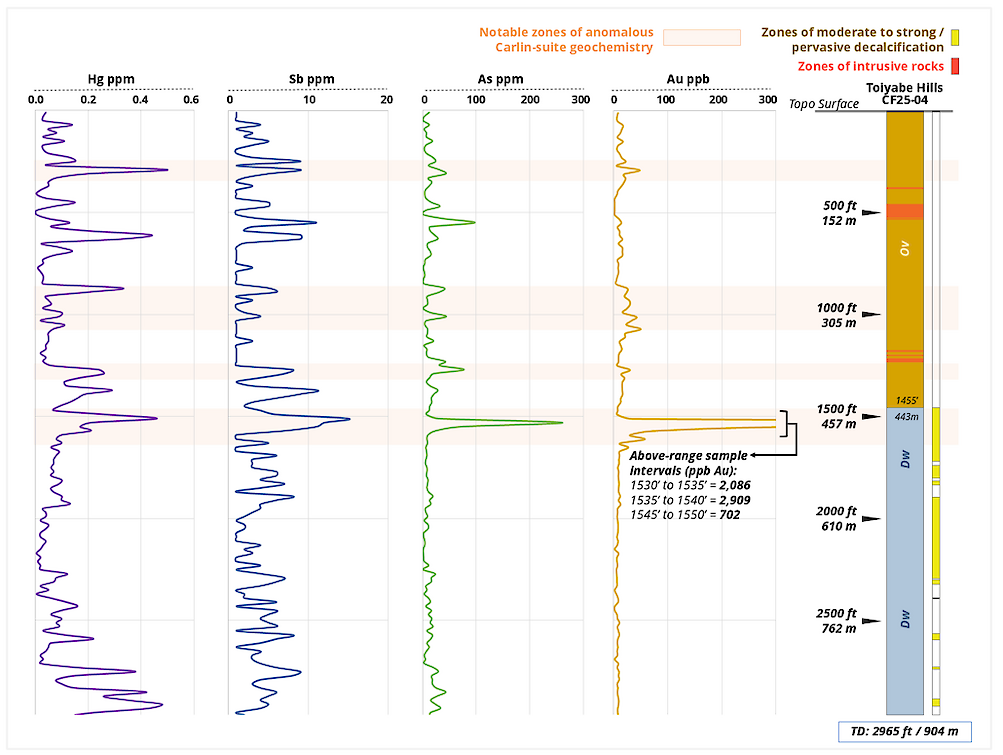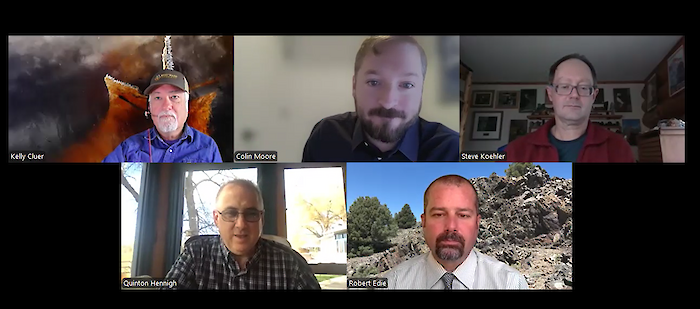The framework drilling strategy has identified a vertically-extensive hydrothermal system and a new Carlin-type gold zone at Campfire
Westward Gold Inc. (CSE: WG, OTCQB: WGLIF, FSE: IM50) (“Westward” or the “Company”) is pleased to provide results for two reverse-circulation (“RC”) drill holes (CF25-03 and CF25-04) and an update on its ongoing 2025 drilling campaign, at its flagship Toiyabe Hills Property in Lander County, Nevada (“Toiyabe Hills”, or the “Property”). Originally, Westward set out to test its high-priority Campfire Target Complex (“Campfire”) with approximately 5,000 metres (~16,500 feet) of RC drilling (see press release date July 8, 2025, for additional details). Due to early technical and drilling successes at this framework stage, additional exploration capital was put to work to expand the program, which now includes 7,090 metres of RC drilling across eleven drill holes (see Figure 1 below for a map of completed and in-progress holes at Campfire). Early results now include a new gold zone of 10.7m of 0.94 g Au/t, including 3.1m of 2.50 g Au/t in hole CF25-04. All samples continue to be sent to Paragon Geochemical Services Inc. (“Paragon”) for gold and multi-element analysis.
Roundtable video discussion available here: https://youtu.be/OCh4KXkjJgQ
The Company’s Phase 1 framework drilling program at Campfire – designed with approximately 350 to 700-metre hole spacings – was intended to characterize large-scale gold system patterns and answer key geological questions by: 1) determining the third-dimension architecture of the favourable lower-plate carbonate rocks; 2) identifying vertically-extensive Carlin-type alteration in lower-plate carbonate rocks (namely decalcification) over a large area; 3) confirming a Carlin-type gold and trace-element signature associated with the hydrothermal system; and 4) confirming the downdip expression of an igneous dike-filled fault corridor within the Campfire Anticline. To date, these key questions are being successfully answered with the Phase 1 framework drilling.
Kelly Cluer, Director, noted “As I was scrolling down the CF25-04 assay report, what really caught my attention was a 39-metre zone in the Wenban Formation containing elevated gold, arsenic, antimony and mercury, which also included 3 metres of 2+ g/t gold. This is precisely what we’ve been hoping to see at this early stage: geochemical evidence of a system that can produce both tonnage and grade, and we were rewarded in that regard in only the fourth hole back from the lab. This is a brand-new gold zone at Toiyabe Hills, essentially stumbled into with a wide-spaced drilling array. I’m more excited than ever to see what comes from the entire 2025 Campfire framework drilling campaign, and what targets will emerge as we digest all the downhole data over the winter.”
Figure 1: Campfire Target: Completed & In-Progress Drilling

Key Drilling Highlights at the Campfire Complex:
- The 10.7m of 0.94 g Au/t, including 3.1m of 2.50 g Au/t, in hole CF25-04 is associated with decalcified, quartz and dolomite veined silty limestone of the Wenban Formation. Arsenic, antimony and mercury – elements typically associated with Carlin-type gold systems – are elevated in this gold zone (see Figure 3 below). Additionally, a 132m-thick shear zone containing strong/pervasive decalcification, quartz veining and/or selvages of silicification, discrete zones of oxidation, and elevated sooty sulfides was intersected from approximately 567m to 700m downhole. This structural zone is reminiscent of blind compressional structures that are well-documented controls for Carlin-type gold systems throughout the neighbouring Cortez District.
- The 3.1m interval of 0.67 g Au/t in hole CF25-03 is hosted in decalcified, silicified, sooty pyrite-bearing silty limestone of the Wenban Formation. Elevated arsenic, antimony and mercury values are also characteristic of this gold zone (see Figure 2 below).
- The gold intervals in holes CF25-03 and -04 represent a new zone of gold at the Toiyabe Hills Project.
- Nine of eleven holes have intersected favourable lower-plate carbonate rocks (see Table 1) at direct drilling costs that are below budget at US$64 / foot. Of the ten holes collared in upper-plate rocks, eight intersected lower-plate rocks at shallower-than-anticipated depths. Vertically-extensive decalcification, an alteration type characteristic of Carlin-type gold systems, and sulfidized igneous dikes have been observed in all holes. Approximately 59% of the Phase 1 drilling metreage has been in favourable lower-plate rocks.
- Drilling has confirmed a fully-preserved, lower-plate-hosted, Carlin-type gold system over a plan extent of approximately 1.6km by 1.0km. The hydrothermal alteration cell at Campfire remains open in all directions and at depth.
- The framework drilling at Campfire has set Westward on a clear path to planning a 2026 Phase II drill campaign. The Company is developing solid subsurface geologic models that demonstrate lower-plate host strata is within easy reach and dipping gently to the NNE. Significant faults and mineralized dikes with known dip and within robust alteration zones can be projected into the best host rocks to target discrete structural intersections where grade is likely to increase. This is the grade hunting phase.
- Difficult drilling conditions were encountered in drill holes CF25-01, -03, -05, -06, -09 and -09A, which resulted in either zones of no sample recovery or holes being terminated prior to fully testing the intended target.
Table 1: Campfire Target Drill Hole Table

Figure 2: Campfire Target: CF25-03 Downhole Geology and Geochemistry

Figure 3: Campfire Target: CF25-04 Downhole Geology and Geochemistry

Quality Assurance / Quality Control (“QA/QC”)
The Company is implementing a best-practices QA/QC program during its 2025 drilling campaign. All sampling is being conducted under the supervision of the Company’s Vice President Exploration and/or members of its technical team, and the chain of custody from the Property to the sample preparation facility is being continuously monitored. Samples are being transported directly from the field to Paragon’s facility located at 1555 Industrial Way, Sparks, NV, 89431. Samples are dried at 100 degrees Celsius, crushed to 70% passing 10-mesh, riffle split 250 grams, and pulverized to 85% passing 200-mesh. Fire assay and multi-element analysis will be completed at the same location. RC samples are being collected in five-foot intervals. Certified standards and blanks are being inserted every 13 samples for a frequency of 8% or greater. Rig duplicates, coarse duplicates, and pulp duplicates are being collected or created at a frequency of 6%. Standards and blanks were sourced from MEG LLC of Lamoille, NV. All samples will be analyzed for gold and 35 additional elements. Assays will consist of fire assays (Au-FA30) for gold, and aqua regia / ICP-OES (35AR-OES) for multi-element geochemistry. Drill-hole deviation for the submitted holes was measured by gyroscopic down-hole surveys with tooling provided by REFLEX of Elko, NV. The deviation surveys provide accurate data about the true inclination and azimuth of the holes. Obtaining an accurate survey of the drill holes leads to a better contextual understanding of the RC samples, and a more robust 3D geological model.
Qualified Person
The technical information contained in this news release was reviewed and approved by Robert Edie, Vice President Exploration of the Company, who is a Qualified Person under National Instrument 43-101 – Standards of Disclosure for Mineral Projects. Mr. Edie is a Certified Professional Geologist (CPG) through the American Institute of Professional Geologists (AIPG).
About Westward Gold
Westward Gold is a mineral exploration company focused on developing the Toiyabe Hills Project located in the Cortez Hills area of Lander County, Nevada, and the Coyote and Rossi Projects located along the Carlin Trend in Elko County, Nevada. From time to time, the Company may also evaluate the acquisition of other mineral exploration assets and opportunities.
For further information contact:
Andrew Nelson
Chief Financial Officer
Westward Gold Inc.
+1 (604) 828-7027
andrew@westwardgold.com
www.westwardgold.com
The Canadian Securities Exchange has neither approved nor disapproved the contents of this news release. The Canadian Securities Exchange does not accept responsibility for the adequacy or accuracy of this news release.
This news release contains or incorporates by reference “forward-looking statements” and “forward-looking information” as defined under applicable Canadian securities legislation. All statements, other than statements of historical fact, which address events, results, outcomes, or developments that the Company expects to occur are, or may be deemed, to be, forward-looking statements. Forward-looking statements are generally, but not always, identified by the use of forward-looking terminology such as "expect", "believe", "anticipate", "intend", "estimate”, “potential”, “on track”, “forecast", "budget", “target”, “outlook”, “continue”, “plan” or variations of such words and phrases and similar expressions or statements that certain actions, events or results “may”, “could”, “would”, “might” or “will” be taken, occur or be achieved or the negative connotation of such terms.
Such statements include, but may not be limited to, information as to strategy, plans or future financial or operating performance, such as the Company’s expansion plans, project timelines, expected drilling targets, and other statements that express management’s expectations or estimates of future plans and performance.
Forward-looking statements or information are subject to a variety of known and unknown risks, uncertainties and other factors that could cause actual events or results to differ from those reflected in the forward-looking statements or information, including, without limitation, the need for additional capital by the Company through financings, and the risk that such funds may not be raised; the speculative nature of exploration and the stages of the Company’s properties; the effect of changes in commodity prices; regulatory risks that development of the Company’s material properties will not be acceptable for social, environmental or other reasons, availability of equipment (including drills) and personnel to carry out work programs, that each stage of work will be completed within expected time frames, that current geological models and interpretations prove correct, the results of ongoing work programs may lead to a change of exploration priorities, and the efforts and abilities of the senior management team. This list is not exhaustive of the factors that may affect any of the Company’s forward-looking statements or information. These and other factors may cause the Company to change its exploration and work programs, not proceed with work programs, or change the timing or order of planned work programs. Additional risk factors and details with respect to risk factors that may affect the Company’s ability to achieve the expectations set forth in the forward-looking statements contained in this news release are set out in the Company’s latest management discussion and analysis under “Risks and Uncertainties”, which is available under the Company’s SEDAR+ profile at www.sedarplus.ca. Although the Company has attempted to identify important factors that could cause actual results to differ materially, there may be other factors that cause results not to be as anticipated, estimated, described or intended. Accordingly, readers should not place undue reliance on forward-looking statements or information. The Company’s forward-looking statements and information are based on the assumptions, beliefs, expectations, and opinions of management as of the date of this press release, and other than as required by applicable securities laws, the Company does not assume any obligation to update forward-looking statements and information if circumstances or management’s assumptions, beliefs, expectations or opinions should change, or changes in any other events affecting such statements or information.

